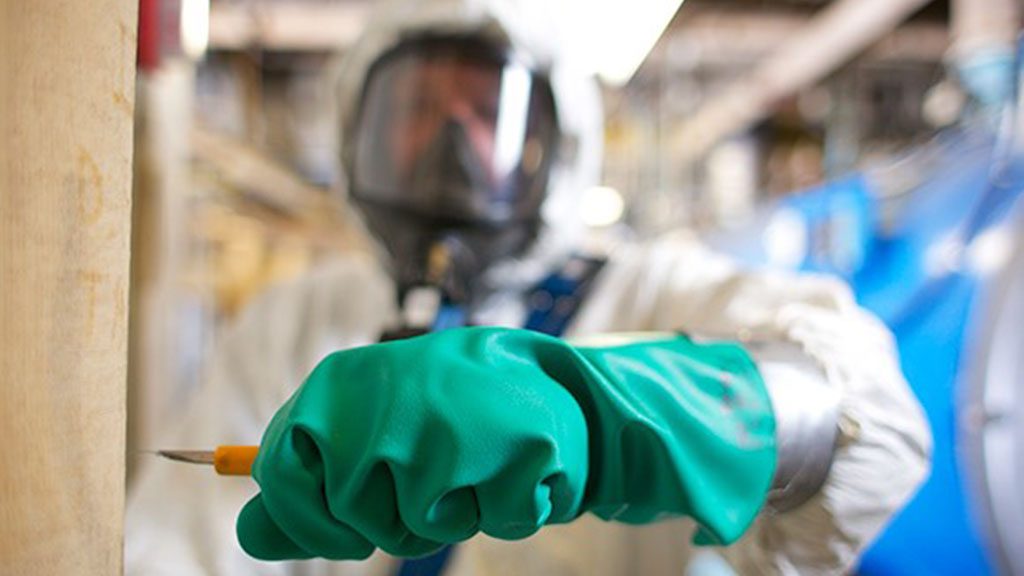Employers are responsible for the health and safety of their workers, and that includes protecting them from asbestos exposure.
Asbestos is a naturally occurring fibrous material that was used in more than 3,000 building materials predominantly from the 1950s to 1990s. Common sources include:
- Vinyl and linoleum flooring
- Stucco
- Loose-blown insulation
- Roof felt shingles
- Gypsum board filling compound
- Textured ceilings and finishes
- Pipe insulation
The risk of exposure
Asbestos exposure is the number one killer of workers in B.C. and, according to WorkSafeBC reports, was the contributing factor in 45 work-related deaths in 2018.
When asbestos-containing materials are disturbed, intentionally or unintentionally, asbestos fibers can be released into the air. Once airborne, inhalation to asbestos poses a serious risk. Long-term exposures to harmful airborne asbestos fibers can cause serious health problems such lung cancers like malignant pleural mesothelioma and other non-malignant lung diseases.
Keep your workers safe by developing an inventory of asbestos-containing materials
If you’re a commercial property owner, property manager, or maintenance worker, asbestos awareness should be a high priority. To determine if there’s an asbestos exposure risk to your workers, Part 6 of the Occupational Health and Safety Regulation requires that building materials suspected of containing asbestos are assessed; and all determined asbestos-containing materials are identified and labelled. Some key notes about the inventory:
- The inventory must be completed by a qualified person. A qualified person must have the appropriate knowledge (through education and training) and experience in the management and control of asbestos hazards. Appropriate credentials may include: Certified industrial hygienist (CIH), registered occupational hygienist (ROH), certified safety professional (CSP), Canadian registered safety professional (CRSP), or professional engineer (P. Eng.), provided that the holders of these qualifications have experience in the recognition, evaluation, and control of asbestos hazards. For more information, please refer to the WorkSafeBC guideline.
- The surveyor will take the appropriate number of samples to be analyzed by a qualified lab and then provide a report that includes a detailed inventory of asbestos materials, a risk assessment, and recommendations on whether the asbestos-containing materials should be safely contained or removed.
Once the report is finalized; the employer will need to make arrangements for labelling of all known-asbestos containing materials.
Finally, if renovation or demolition activities are required, a more thorough pre-demolition hazardous materials survey must be completed as per OHS20.112 of the Occupational Health and Safety Regulation.
Asbestos management program
The inventory is the foundation of an asbestos management program. For building owners and property managers of both residential and commercial properties, this program is an effective system to manage the safety of any workers or contractors who could be exposed to asbestos during their work.
An asbestos management program should include the following:
- An up-to-date inventory of all asbestos-containing materials in the building, including the condition of those materials and any changes that have been made (removals, renovations)
- Labeling of all asbestos-containing materials
- Continuous management of existing asbestos-containing materials (assessments)
- Written safe work procedures specific to the worksite. Please note that should workers or contractors require to disturb asbestos as part of their tasks; they need the appropriate education and training.
- Education for all involved personnel of the worksite specific safe work procedures
- Continuous audits of the program to ensure its effectiveness in managing asbestos-containing materials in the workplace
Asbestos health and safety resources
Make sure to identify asbestos properly, have it removed safely, and follow safe work procedures and protect everyone from the dangers of asbestos.
For more information and resources, visit worksafebc.com/asbestos



Recent Comments
comments for this post are closed